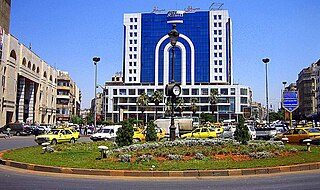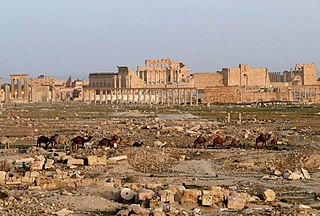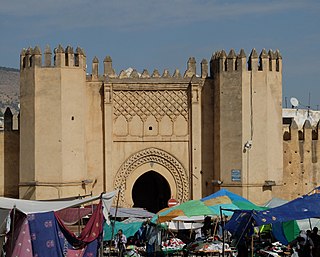Coordinates: 34°43′23″N36°42′52″E / 34.723185°N 36.714462°E

A geographic coordinate system is a coordinate system that enables every location on Earth to be specified by a set of numbers, letters or symbols. The coordinates are often chosen such that one of the numbers represents a vertical position and two or three of the numbers represent a horizontal position; alternatively, a geographic position may be expressed in a combined three-dimensional Cartesian vector. A common choice of coordinates is latitude, longitude and elevation. To specify a location on a plane requires a map projection.
| Old City of Homs |
|---|
The Gates of Homs refer to gates of the city of Homs in central Syria. Historically under the Abbasid dynasty, the city had seven gates. [1] They were the following:

Homs, previously known as Emesa or Emisa, is a city in western Syria and the capital of the Homs Governorate. It is 501 metres (1,644 ft) above sea level and is located 162 kilometres (101 mi) north of Damascus. Located on the Orontes River, Homs is also the central link between the interior cities and the Mediterranean coast.

Syria, officially the Syrian Arab Republic, is a country in Western Asia, bordering Lebanon to the southwest, the Mediterranean Sea to the west, Turkey to the north, Iraq to the east, Jordan to the south, and Israel to the southwest. A country of fertile plains, high mountains, and deserts, Syria is home to diverse ethnic and religious groups, including Syrian Arabs, Greeks, Armenians, Assyrians, Kurds, Circassians, Mandeans and Turks. Religious groups include Sunnis, Christians, Alawites, Druze, Isma'ilis, Mandeans, Shiites, Salafis, Yazidis, and Jews. Sunni make up the largest religious group in Syria.
- Bab al-Souq (Gate of the Market), thought to have been located on the southwestern corner of the al-Nouri Mosque.
- Bab Tadmur (Gate of Palmyra) located on the northeastern side of the wall.
- Bab al-Dirayb (or Bab al-Dayr) located on the eastern side of the wall.
- Bab al-Sebaa (Gate of the Lions) located east of the citadel, and leads to the Old City.
- Bab al-Turkman (Gate of the Turkmen) located on the northwestern corner of the citadel at a point where it intersects with the walls.
- Bab al-Masdoud (Closed Door) located to the north of Bab al-Turkman.
- Bab Hud (The Gate of Hud), named after the mausoleum of the prophet Hud, which lies just south of the gate.

Palmyra is an ancient Semitic city in present-day Homs Governorate, Syria. Archaeological finds date back to the Neolithic period, and documents first mention the city in the early second millennium BC. Palmyra changed hands on a number of occasions between different empires before becoming a subject of the Roman Empire in the first century AD.

Hud was a prophet of ancient Arabia mentioned in the Qur’an. The eleventh chapter of the Quran, Hud, is named after him, though the narrative of Hud comprises only a small portion of the chapter.
The Ottomans tore down most of the gates in the 19th century. Only three gates (Bab Tadmor, Bab Hud and Bab al-Dreib) and a small strip of the city walls remain intact. [2]

The Ottoman Empire, historically known in Western Europe as the Turkish Empire or simply Turkey, was a state that controlled much of Southeast Europe, Western Asia and North Africa between the 14th and early 20th centuries. It was founded at the end of the 13th century in northwestern Anatolia in the town of Söğüt by the Oghuz Turkish tribal leader Osman I. After 1354, the Ottomans crossed into Europe, and with the conquest of the Balkans, the Ottoman beylik was transformed into a transcontinental empire. The Ottomans ended the Byzantine Empire with the 1453 conquest of Constantinople by Mehmed the Conqueror.
















